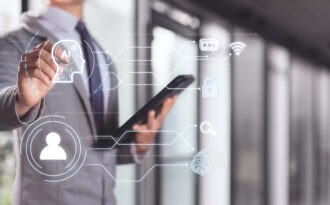

5 min lesen
November 16, 2023
Today’s digital technology primarily relies on two senses: sight and hearing. However, it may not be long before we can feel, taste, and smell digital objects in a way that is indistinguishable from physical objects. With rapid advancements in AR and VR applications and the hyperconnectivity of 5G, digital experiences could evolve from screen-based to sensory-based experiences in the coming decades.
Developed by the Swedish telecommunications giant Ericsson, the Internet of Senses (IoS) can be considered the next stage of digitalization. IoS envisions a world where the digital and physical gradually merge, as digital technologies increasingly replicate and enhance the five human senses. With ever-lighter and more advanced AR glasses and contact lenses, users will soon be able to project digital objects into physical environments with an astonishing degree of realism. In the era of the Internet of Things, the sense of touch will be further enhanced.
The visual, auditory, haptic, and other technologies of the Internet of Senses enable people to experience digital sensory perceptions similar to those in the real world. The Internet of Senses extends our senses beyond our bodies by providing enhanced visual, auditory, tactile, and olfactory experiences. It allows us to combine multimodal digital experiences with our immediate surroundings, enabling interaction with distant people, machines, and robots as if they were right next to us. The Internet of Senses is defined by sensory experiences transmitted over networks, as demonstrated by use cases such as merging the five senses with reality, immersive communication, remote machine control, online shopping with all senses, and sustainable vacations in virtual reality.
By making our digital interactions multimodal, the Internet of Senses transforms them into truly immersive experiences. Imagine being transported to a beach, feeling the wind on your face, the sun on your back, the moisture of the sea air on your skin, and inhaling the fresh scent of the ocean breeze—all from the comfort of your living room. The Internet of Senses will be the result of such multimodal experiences transmitted over future networks.
The Internet of Senses has the potential to drastically reduce the need for travel and even workplaces by enabling digital experiences and interactions that are as good as being physically present, significantly contributing to the reduction of greenhouse gas emissions. Digital sensory experiences can help dematerialize objects and improve services, consuming fewer resources and less energy. The Internet of Senses is based on the idea of using the brain as an interface to exchange cognitive sensory impressions with the user. This ingenious concept would blur the boundary between physical and digital experiences. With minimal or no physical effort, such technology would be able to receive inputs directly from thoughts and generate outputs in the form of sensory impressions. IoS would make it possible to eliminate most human-machine interfaces (HMI), such as keyboards, mice, joysticks, and even touch-based user interfaces. Advanced augmented reality glasses (AR glasses) would undoubtedly serve as a visual aid for sensory interactions. This will lead to numerous breakthroughs to meet new demands.
When the Internet of Senses becomes a reality, the consumer electronics industry will benefit the most. Existing products would evolve to interact with the mind and exchange sensory inputs. Some possible applications for the Internet of Senses in the coming decade include:
The Internet of Senses is a bold prediction based on the rapid technological advancements of the last decade. The fact that this concept is feasible demonstrates how far technology has progressed. However, this new path will come with unknown challenges. After all, anything that interacts with human senses or thoughts must be secure, confidential, and error-free. The importance of robustness in such a product cannot be overstated.
Brain-computer gateways already exist, and it will not be long before IoS becomes a reality. The Internet of Senses may become a part of our lives sooner than expected.

October 8, 2025
The biomethane sector is entering a decisive phase. Driven by climate targets, stricter regulations, and rising demand for renewable energy, the market is experiencing rapid growth. Yet, this expansion also creates new op...

February 3, 2025
The future of ERP lies in more efficient and flexible business solutions. In this article, you will discover how .NET-based ERP systems help you optimize processes while remaining adaptable. Explore the key benefits and technological advancemen...